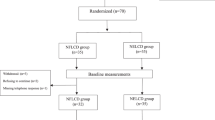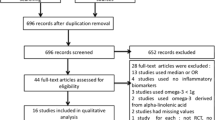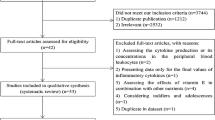Abstract
Background:
3-Hydroxy-3-methyl-glutaryl-coenzyme A (HMG-CoA) reductase inhibitors (statins) markedly reduce serum cholesterol and have anti-inflammatory effects. The effect of cholesterol-lowering diets on inflammatory biomarkers is less well known.
Objective:
To compare the efficacy of a dietary combination (portfolio) of cholesterol-lowering foods vs a statin in reducing C-reactive protein (CRP) as a biomarker of inflammation linked to increased cardiovascular disease risk.
Methods:
In all, 34 hyperlipidemic subjects completed three 1-month treatments as outpatients in random order: a very low-saturated fat diet (control); the same diet with 20 mg lovastatin (statin); and a diet high in plant sterols (1.0 g/1000 kcal), soy protein (21.4 g/1000 kcal), viscous fibers (9.8 g/1000 kcal), and almonds (14 g/1000 kcal) (portfolio). Fasting blood samples were obtained at weeks 0, 2, and 4.
Results:
Using the complete data, no treatment reduced serum CRP. However, when subjects with CRP levels above the 75th percentile for previously reported studies (>3.5 mg/l) were excluded, CRP was reduced similarly on both statin, −16.3±6.7% (n=23, P=0.013) and dietary portfolio, −23.8±6.9% (n=25, P=0.001) but not the control, 15.3±13.6% (n=28, P=0.907). The percentage CRP change from baseline on the portfolio treatment (n=25) was greater than the control (n=28, P=0.004) but similar to statin treatment (n=23, P=0.349). Both statin and portfolio treatments were similar in reducing CRP and numerically more effective than control but only the change in portfolio was significant after the Bonferroni adjustment.
Conclusions:
A combination of cholesterol-lowering foods reduced C-reactive protein to a similar extent as the starting dose of a first-generation statin.
This is a preview of subscription content, access via your institution
Access options
Subscribe to this journal
Receive 12 print issues and online access
$259.00 per year
only $21.58 per issue
Buy this article
- Purchase on Springer Link
- Instant access to full article PDF
Prices may be subject to local taxes which are calculated during checkout


Similar content being viewed by others
References
Albert MA, Glynn RJ & Ridker PM (2003): Alcohol consumption and plasma concentration of C-reactive protein. Circulation 107, 443–447.
Albert MA, Glynn RJ & Ridker PM (2004): Effect of physical activity on serum C-reactive protein. Am. J. Cardiol. 93, 221–225.
Blok WL, Deslypere JP, Demacker PN, van der Ven-Jongekrijg J, Hectors MP, van der Meer JW & Katan MB (1997): Pro- and anti-inflammatory cytokines in healthy volunteers fed various doses of fish oil for 1 year. Eur. J. Clin. Invest. 27, 1003–1008.
Box GEP & Cox DR (1964): An analysis of transformation. JR. Stat. Soc. (B) 26, 211–252.
Ceriello A & Motz E (2004): Is oxidative stress the pathogenic mechanism underlying insulinresistance, diabetes and cardiovascular disease: the common soil hypothesis revisited. Arterioscler. Thromb. Vasc. Biol. 24, 816–823.
Cortellaro M, Cofrancesco E, Boschetti C, Cortellaro F, Mancini M & Mariani M (2000): Effects of fluvastatin and bezafibrate combination on plasma fibrinogen, t-plasminogen activator inhibitor and C reactive protein levels in coronary artery disease patients with mixed hyperlipidaemia (FACT study). Fluvastatin alone and in combination treatment. Thromb. Haemost. 83, 549–553.
Cushman M, Legault C, Barrett-Connor E, Stefanick ML, Kessler C, Judd HL, Sakkinen PA & Tracy RP (1999): Effect of postmenopausal hormones on inflammation-sensitive proteins: the Postmenopausal Estrogen/Progestin Interventions (PEPI) Study. Circulation 100, 717–722.
Danesh J, Wheeler JG, Hirschfield GM, Eda S, Eiriksdottir G, Rumley A, Lowe GD, Pepys MB & Gudnason V (2004): C-reactive protein and other circulating markers of inflammation in the prediction of coronary heart disease. N. Engl. J. Med. 350, 1387–1397.
Dangas G, Badimon JJ, Smith DA, Unger AH, Levine D, Shao JH, Meraj P, Fier C, Fallon JT & Ambrose JA (1999): Pravastatin therapy in hyperlipidemia: effects on thrombus formation and the systemic hemostatic profile. J. Am. Coll. Cardiol. 33, 1294–1304.
Downs JR, Clearfield M, Weis S, Whitney E, Shapiro DR, Beere PA, Langendorfer A, Stein EA, Kruyer W & Gotto Jr AM (1998): Primary prevention of acute coronary events with lovastatin in men and women with average cholesterol levels: results of AFCAPS/TexCAPS. Air Force/Texas Coronary Atherosclerosis Prevention Study. JAMA 279, 1615–1622.
Expert Panel on Detection, Evaluation, and Treatment of High Blood Cholesterol in Adults (2001): Executive summary of The Third Report of The National Cholesterol Education Program (NCEP) Expert Panel on Detection, Evaluation, and Treatment of High Blood Cholesterol In Adults (Adult Treatment Panel III). JAMA 285, 2486–2497.
Ford ES (1999): Body mass index, diabetes, and C-reactive protein among US adults. Diabetes Care 22, 1971–1977.
Foster-Powell K, Holt SH & Brand-Miller JC (2002): International table of glycemic index and glycemic load values: 2002. Am. J. Clin. Nutr. 76, 5–56.
Frohlich M, Sund M, Lowel H, Imhof A, Hoffmeister A & Koenig W (2003): Independent association of various smoking characteristics with markers of systemic inflammation in men. Results from a representative sample of the general population (MONICA Augsburg Survey 1994/95). Eur. Heart J. 24, 1365–1372.
Heart Protection Study Collaborative Group (2002): MRC/BHF Heart Protection Study of cholesterol lowering with simvastatin in 20 536 high-risk individuals: a randomised placebo-controlled trial. Lancet 360, 7–22.
Herrington DM, Vittinghoff E, Lin F, Fong J, Harris F, Hunninghake D, Bittner V, Schrott HG, Blumenthal RS & Levy R (2002): Statin therapy, cardiovascular events, and total mortality in the Heart and Estrogen/Progestin Replacement Study (HERS). Circulation 105, 2962–2967.
Jenkins DJ, Kendall CW, Connelly PW, Jackson CJ, Parker T, Faulkner D & Vidgen E (2002a): Effects of high- and low-isoflavone (phytoestrogen) soy foods on inflammatory biomarkers and proinflammatory cytokines in middle-aged men and women. Metabolism 51, 919–924.
Jenkins DJ, Kendall CW, Faulkner D, Vidgen E, Trautwein EA, Parker TL, Marchie A, Koumbridis G, Lapsley KG, Josse RG, Leiter LA & Connelly PW (2002b): A dietary portfolio approach to cholesterol reduction: combined effects of plant sterols, vegetable proteins, and viscous fibers in hypercholesterolemia. Metabolism 51, 1596–1604.
Jenkins DJ, Kendall CW, Marchie A, Parker TL, Connelly PW, Qian W, Haight JS, Faulkner D, Vidgen E, Lapsley KG & Spiller GA (2002c): Dose response of almonds on coronary heart disease risk factors: blood lipids, oxidized low-density lipoproteins, lipoprotein(a), homocysteine, and pulmonary nitric oxide: a randomized, controlled, crossover trial. Circulation 106, 1327–1332.
Jenkins DJ, Kendall CW, Marchie A, Faulkner DA, Wong JM, de Souza R, Emam A, Parker TL, Vidgen E, Lapsley KG, Trautwein EA, Josse RG, Leiter LA & Connelly PW (2003): Effects of a dietary portfolio of cholesterol-lowering foods vs lovastatin on serum lipids and C-reactive protein. JAMA 290, 502–510.
Jenkins DJ, Kendall CW, Marchie A, Faulkner D, Wong J, de Sousa R, Emam A, Parker T, Vidgen E, Trautwein E, Lapsley K, Josse RG, Leither LA, Singer W & Connelly PW (2005): Direct comparison of a dietary portfolio of cholesterol-lowering foods with a statin in hypercholesterolemic participants. Am. J. Clin. Nutr. 81, 380–387.
Jenkins DJ, Wolever TM, Leeds AR, Gassull MA, Haisman P, Dilawari J, Goff DV, Metz GL & Alberti KG (1978): Dietary fibres, fibre analogues, and glucose tolerance: importance of viscosity. BMJ 27, 1392–1394.
Kalela A, Laaksonen R, Lehtimaki T, Koivu TA, Hoyhtya M, Janatuinen T, Pollanen P, Vesalainen R, Saikku P, Knuuti J & Nikkari ST (2001): Effect of pravastatin in mildly hypercholesterolemic young men on serum matrix metalloproteinases. Am. J. Cardiol. 88, 173–175. A6.
Ledue TB & Rifai N (2003): Preanalytic and analytic sources of variations in C-reactive protein measurement: implications for cardiovascular disease risk assessment. Clin. Chem. 49, 1258–1271.
Lemieux I, Pascot A, Prud’homme D, Almeras N, Bogaty P, Nadeau A, Bergeron J & Despres JP (2001): Elevated C-reactive protein: another component of the atherothrombotic profile of abdominal obesity. Arterioscler. Thromb. Vasc. Biol. 21, 961–967.
Liu S, Manson JE, Buring JE, Stampfer MJ, Willett WC & Ridker PM (2002): Relation between a diet with a high glycemic load and plasma concentrations of high-sensitivity C-reactive protein in middle-aged women. Am. J. Clin. Nutr. 75, 492–498.
Neter J, Wasserman W & Kutner MH (1985): Applied Linear Statistical Models. IL: Irwin Homewood.
Ockene IS, Matthews CE, Rifai N, Ridker PM, Reed G & Stanek E (2001): Variability and classification accuracy of serial high-sensitivity C-reactive protein measurements in healthy adults. Clin. Chem. 47, 444–450.
Pearson TA, Mensah GA, Alexander RW, Anderson JL, Cannon 3rd RO, Criqui M, Fadl YY, Fortmann SP, Hong Y, Myers GL, Rifai N, Smith Jr SC, Taubert K, Tracy RP & Vinicor F (2003): Markers of inflammation and cardiovascular disease: application to clinical and public health practice: a statement for healthcare professionals from the Centers for Disease Control and Prevention and the American Heart Association. Circulation 107, 499–511.
Pischon T, Hankinson SE, Hotamisligil GS, Rifai N, Willett WC & Rimm EB (2003): Habitual dietary intake of n-3 and n-6 fatty acids in relation to inflammatory markers among US men and women. Circulation 108, 155–160.
Pradhan AD, Manson JE, Rossouw JE, Siscovick DS, Mouton CP, Rifai N, Wallace RB, Jackson RD, Pettinger MB & Ridker PM (2002): Inflammatory biomarkers, hormone replacement therapy, and incident coronary heart disease: prospective analysis from the Women's Health Initiative observational study. JAMA 288, 980–987.
Rattazzi M, Puato M, Faggin E, Bertipaglia B, Zambon A & Pauletto P (2003): C-reactive protein and interleukin-6 in vascular disease: culprits or passive bystanders? J. Hypertens. 21, 1787–1803.
Ridker PM, Buring JE, Shih J, Matias M & Hennekens CH (1998a): Prospective study of C-reactive protein and the risk of future cardiovascular events among apparently healthy women. Circulation 98, 731–733.
Ridker PM, Glynn RJ & Hennekens CH (1998b): C-reactive protein adds to the predictive value of total and HDL cholesterol in determining risk of first myocardial infarction. Circulation 97, 2007–2011.
Ridker PM, Hennekens CH, Rifai N, Buring JE & Manson JE (1999): Hormone replacement therapy and increased plasma concentration of C-reactive protein. Circulation 100, 713–716.
Ridker PM, Rifai N, Clearfield M, Downs JR, Weis SE, Miles JS & Gotto Jr AM (2001): Air Force/Texas Coronary Atherosclerosis Prevention Study Investigators. Measurement of C-reactive protein for the targeting of statin therapy in the primary prevention of acute coronary events. N. Engl. J. Med. 344, 1959–1965.
Ridker PM, Rifai N, Rose L, Buring JE & Cook NR (2002): Comparison of C-reactive protein and low-density lipoprotein cholesterol levels in the prediction of first cardiovascular events. N. Engl. J. Med. 347, 1557–1565.
Rifai N & Ridker PM (2002): Inflammatory markers and coronary heart disease. Curr. Opin. Lipidol. 13, 383–389.
Rifai N & Ridker PM (2003): Population distributions of C-reactive protein in apparently healthy men and women in the United States: implication for clinical interpretation. Clin. Chem. 49, 666–669.
Sacks FM, Tonkin AM, Shepherd J, Braunwald E, Cobbe S, Hawkins CM, Keech A, Packard C, Simes J, Byington R & Furberg CD (2000): Effect of pravastatin on coronary disease events in subgroups defined by coronary risk factors: the Prospective Pravastatin Pooling Project. Circulation 102, 1893–1900.
SAS Institute (1997): SAS/STAT User's Guide (ed 6.12). Cary, NC: SAS Institute.
Scandinavian Simvastatin Survival Study Group (1994): Randomized trial of cholesterol lowering in 4444 patients with coronary heart disease: the Scandinavian Simvastatin Survival Study (4S). Lancet 344, 1383–1389.
Shepherd J, Cobbe SM, Ford I, Isles CG, Lorimer AR, MacFarlane PW, McKillop JH & Packard CJ (1995): Prevention of coronary heart disease with pravastatin in men with hypercholesterolemia. West of Scotland Coronary Prevention Study Group. N. Engl. J. Med. 333, 1301–1307.
Tall AR (2004): C-reactive protein reassessed. N. Engl. J. Med. 350, 1450–1452.
The Homocysteine Studies Collaboration (2002): Homocysteine and risk of ischemic heart disease and stroke: a meta-analysis. JAMA 288, 2015–2022.
Tillet WS & Francis T (1930): Serological reaction in pneumonia with a non-protein somatic fraction of pneumococcus. J. Exp. Med. 52, 561–571.
Wolever TMS, Chiasson JL, Josse RG, Leiter LA, Maheux P, Rabasa-Lhoret R, Rodger NW & Ryan EA (2004): Effect of modifying source or amount of carbohydrate glucose and lipid control in type 2 diabetes. Can. J. Diab. 48 (Suppl 1) (CDA abstract).
Yudkin JS, Stehouwer CD, Emeis JJ & Coppack SW (1999): C-reactive protein in healthy subjects: associations with obesity, insulin resistance, and endothelial dysfunction: a potential role for cytokines originating from adipose tissue? Arterioscler. Thromb. Vasc. Biol. 19, 972–978.
Acknowledgements
This work was supported by the Canada Research Chair Endowment of the Federal Government of Canada; the Canadian Natural Sciences and Engineering Research Council of Canada; Loblaw Brands Limited (Toronto, ON); Unilever Canada (Toronto, ON); and the Almond Board of California (Modesto, CA).
We sincerely thank President's Choice, Loblaw Brands Limited, Unilever Research & Development (Vlaardingen, the Netherlands), the Almond Board of California, The Hain-Celestial Group (Melville, NY), Kraft Foods (Glenview, IL), Procter & Gamble Inc. (Toronto, ON), Pepsico Foods Canada-Quaker Peterborough Plant (Peterborough, ON), Nestlé Canada Inc. (Pickering, ON), Bartlett Farms, Barwell Food Sales Inc. (London, ON), and Burnbrae Farms (Upton, PQ) for the generous donation of foods used in this study.
We thank Mr Edward Vidgen, Toronto, Canada for statistical support on this project; Mr Larry C Griffin, Ms Sherry Casey, and Mr. Pietro Satriano of President's Choice, Loblaw Brands Ltd; Dr Karen G Lapsley of the Almond Board of California; Dr Elke Trautwein of Unilever (Research and Development); Dr Paul Schur of Unilever Canada; Dr Gerry Amantea of The Hain-Celestial Group; Dr Margaret C Martini of Kraft Foods; Mr Grant Morrison of Pepsico Foods Canada; Ms Kathy Galbraith of Natural Temptations Bakery (Burlington, ON); Mr Don Bartlett of Bartlett Farms, Barwell Foods Sales Inc; Ms Michele Brown of Lean Cuisine Marketing Team of Nestlé Canada; Ms Margaret Hudson of Burnbrae Farms Ltd, for their assistance on this project; and to the study participants for their attention to detail and enthusiasm.
Author information
Authors and Affiliations
Corresponding author
Additional information
Guarantor: DJA Jenkins.
Contributors: Study concept and design: DJAJ, CWCK, DAF. acquisition of data: DJAJ, CWCK, AM, DAF, JMWW, R de S, AE, TLP, TJL, PWC; analysis and interpretation of data: DJAJ, CWCK, DAF, ARJ, TJL, RGJ, LAL, PWC; drafting of the manuscript: DJAJ, CWCK, AM; critical revision of the manuscript for important intellectual content: DJAJ, CWCK, AM, DAF, ARJ, JMWW, R de S, AE, TLP, TJL, RGJ, LAL, WS, PWC; statistical expertise: TJL; obtained funding: DJAJ, CWCK; administrative, technical or material support: CWCK, AM, DAF, JMWW, R de S, AE, TLP, RGJ, LAL, WS, PWC; study supervision: DJAJ, CWCK, DAF.
Rights and permissions
About this article
Cite this article
Jenkins, D., Kendall, C., Marchie, A. et al. Direct comparison of dietary portfolio vs statin on C-reactive protein. Eur J Clin Nutr 59, 851–860 (2005). https://doi.org/10.1038/sj.ejcn.1602152
Received:
Revised:
Accepted:
Published:
Issue Date:
DOI: https://doi.org/10.1038/sj.ejcn.1602152
Keywords
This article is cited by
-
Consumption of diets high in prebiotic fiber or protein during growth influences the response to a high fat and sucrose diet in adulthood in rats
Nutrition & Metabolism (2010)
-
Inflammation and cachexia in chronic kidney disease
Pediatric Nephrology (2010)
-
Baseline plasma plant sterol concentrations do not predict changes in serum lipids, C-reactive protein (CRP) and plasma plant sterols following intake of a plant sterol-enriched food
European Journal of Clinical Nutrition (2009)
-
Effect on hematologic risk factors for coronary heart disease of a cholesterol reducing diet
European Journal of Clinical Nutrition (2007)
-
The portfolio diet for cardiovascular risk reduction
Current Atherosclerosis Reports (2007)



